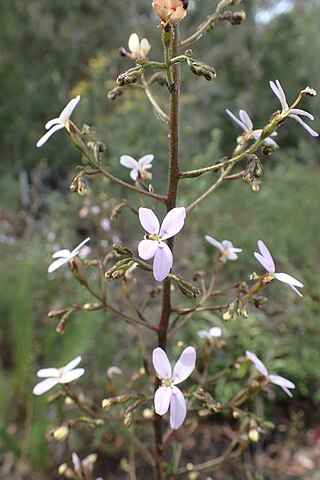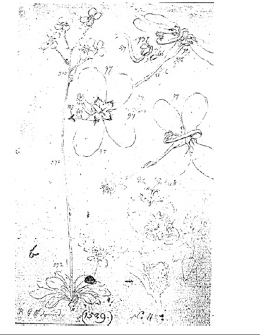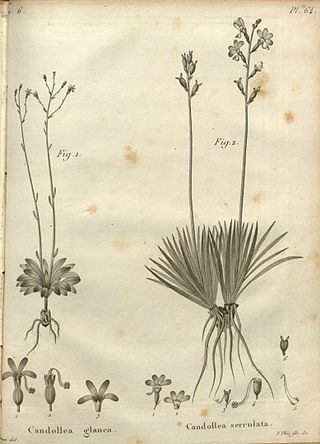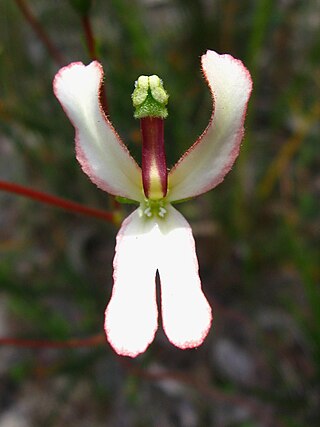
Stylidium is a genus of dicotyledonous plants that belong to the family Stylidiaceae. The genus name Stylidium is derived from the Greek στύλος or stylos, which refers to the distinctive reproductive structure that its flowers possess. Pollination is achieved through the use of the sensitive "trigger", which comprises the male and female reproductive organs fused into a floral column that snaps forward quickly in response to touch, harmlessly covering the insect in pollen. Most of the approximately 300 species are only found in Australia, making it the fifth largest genus in that country. Triggerplants are considered to be protocarnivorous or carnivorous because the glandular trichomes that cover the scape and flower can trap, kill, and digest small insects with protease enzymes produced by the plant. Recent research has raised questions as to the status of protocarnivory within Stylidium.

Stylidium scandens is a dicotyledonous plant that belongs to the genus Stylidium. S. scandens is endemic to Australia and is found primarily in the southwestern region of Western Australia. This species, along with Stylidium nymphaeum, has a unique characteristic among triggerplants in that its leaves, five centimetres long, end in a recurved barb that can grab hold of other vegetation and scramble or climb up to 30–60 cm in height over other plants, which is how it obtained its common name. Its flowers are bright pink and about 15 mm wide.

Stylidium laricifolium, commonly known as giant trigger-plant, larch-leaf or tree triggerplant, or is a species of flowering plant in the family Stylidiaceae and is endemic to eastern Australia. It is a perennial subshrub with many linear leaves crowded along its few stems, the flowers white to pale pink and arranged in a single main panicle and smaller racemes.
Juliet Ann Wege is an Australian botanist. She graduated in 1992 and gained a PhD at The University of Western Australia in 1999 with a thesis titled "Morphological and anatomical variation within Stylidium (Stylidiaceae): a systematic perspective". As of 2021 she works as a researcher at the Western Australian Herbarium run by Western Australia's Department of Biodiversity, Conservation and Attractions and is managing editor of Nuytsia. Her main area of expertise is in taxonomy and study of the Stylidiaceae family of triggerplants.

The scaly-tailed possum is found in northwestern Australia, where it is restricted to the Kimberley.

Stylidium turbinatum is a dicotyledonous plant that belongs to the genus Stylidium. S. turbinatum is endemic to Australia and is found in the northern part of Western Australia in the Kimberley region and near Darwin in the Northern Territory. This species is an erect annual herb that stands 6–15 cm tall. A 2–5 cm long stem bearing scattered leaves terminate in a tuft of 1–2 cm long upper leaves. Several scapes appear from these terminal tufts. The inflorescence is a raceme, which produces pink flowers whose petals are vertically paired. The hypanthium of this species is turbinate and is one of the distinguishing characteristics used to identify it. The sepals form ribs around the hypanthium, giving it a turbine-like appearance. Seeds of S. turbinatum are pale orange and around 0.2 mm long.

Calothamnus quadrifidus, commonly known as one-sided bottlebrush, is a plant in the myrtle family, Myrtaceae and is endemic to the south-west of Western Australia. The common name alludes to the arrangement of the flowers in the inflorescence which line up on one side of the stem. It is a shrub with grey-green, pine-like foliage covered with soft hairs and red, four-part flowers in spring. Widely cultivated because of its attractive foliage, colourful, unusual and prolific flowers, it grows in a variety of habitats and soils. In 2010, Alex George published a review of the species based on recent research and described a number of new subspecies.

Oreostylidium is a genus of flowering plants in the family Stylidiaceae with a single species, Oreostylidium subulatum, that is endemic to New Zealand. O. subulatum is a very small plant with small, white flowers. It has a complicated botanical history that has led to a few proposals to move Oreostylidium to the related genus Stylidium. The researchers cite molecular data and suspect that this species is an extreme example of floral paedomorphosis. This would not be an unprecedented move since the single species was initially described as Stylidium subulatum in 1864 and later moved to its own genus by Sven Berggren in 1878. It possesses the same kind of glandular trichomes underneath the flower that make Stylidium species carnivorous plants, but it has not yet been tested for the presence of digestive enzymes.
Repentes is a section in the subgenus Tolypangium. Repentes is a group of creeping triggerplants known as the locket triggerplants, related to subgenus Nitrangium section Appressae. They possess adpressed stem leaves bearing a small basal spur and uni-flowered inflorescences. Because section Repentes morphologically resembles the other creeping triggerplants in section Appressae, Allen Lowrie et al. (1999) proposed all species in this section be moved to section Appressae and Repentes be placed into synonymy. Juliet Wege (2006), however, argued that these species are morphologically distinct from those in section Appressae, citing trichome and column cunabulum structure as distinctions that separate the sections.
Stylidium longicornu is a dicotyledonous plant that belongs to the genus Stylidium. It is an annual plant that grows from 10 to 30 cm tall. The obovate to spathulate leaves form a basal rosettes around the stem. The leaves are around 4–6 mm long. Inflorescences are unbranched racemes and produce flowers that are violet with white at the base and bloom from June to August in their native range. S. longicornu is endemic to the Kimberley region in Western Australia. Its habitat is recorded as being sand flats near sandstone. It grows in the presence of S. lobuliflorum, Rhynchospora, and Leptocarpus.
Stylidium inaequipetalum, the Ayers Rock triggerplant, is a small herbaceous perennial plant in the genus Stylidium. It grows from 7 to 40 cm tall. Oblanceolate leaves, about 20-100 per plant, form a basal rosette with stems absent. The leaves are generally 15–81 mm long and 2–8 mm wide. This species produces 1-11 scapes per plant. Inflorescences are 7–40 cm long and produce pink flowers with petals all free and blooms almost year-round in their native range. S. inaequipetalum is endemic to the southwestern Northern Territory and Western Australia. Its typical habitat has been reported as sandy soils on sheltered creekbanks or in between rocks. S. inaequipetalum is most closely related to S. floribundum, though it is also closely allied with S. debile.
Stylidium leptorrhizum is a dicotyledonous plant that belongs to the genus Stylidium. It is an herbaceous annual plant that grows from 8 to 25 cm tall. Oblanceolate or elliptical leaves, about 10-20 per plant, form a basal rosette with stems absent. The leaves are generally 14–60 mm long and 3–9.5 mm wide. This species produces 1-3 scapes per plant. Inflorescences are 8–25 cm long and produce pink or mauve flowers that bloom from May to August in their native range. S. leptorrhizum is endemic to the Kimberley region of Western Australia and the Victoria River district of the Northern Territory. Its typical habitat has been reported as sandy soils along creeks or billabongs. S. leptorrhizum is most closely related to S. multiscapum. When reviewing section Debilia, Anthony Bean reduced the recently described S. barrettorum to synonymy with S. leptorrhizum after examining the type specimen.

Annona senegalensis, commonly known as African custard-apple, wild custard apple, wild soursop, abo ibobo, sunkungo, and dorgot is a species of flowering plant in the custard apple family, Annonaceae. The specific epithet, senegalensis, translates to mean "of Senegal", the country where the type specimen was collected.

Stylidium perplexum is a species of triggerplant that is endemic to south-west Western Australia. It is a tuberous species that has many stems and has been described as "somewhat shrubby" at 15–40 cm tall. The linear leaves can be 2 cm long and are arranged around the stem in a rosette at the stem apices. The 8–19 cm tall scapes bear 6 to 14 flowers that are white with purple accents and corolla lobes that are laterally paired and 4–6 mm long.

Stylidium spathulatum is a dicotyledonous plant that belongs to the genus Stylidium. The species is informally named the creamy triggerplant for the colour of its flowers.

Stylidium affine is a species in the genus Stylidium that is endemic to Western Australia.

Stylidium glaucum, the grey triggerplant, is a herbaceous plant found along the southern coast of Southwest Australia, West of Albany. The plant attains a height between 0.15 and 0.65 metres. The leaves are lanceolate in form, becoming pointed at the base, and moderately acute at the tip. These are between 20 and 70 millimetres in length and 2 to 9 millimetres in width, are hairless, and have an entire margin. The trivial name of the species, glaucum, refers to the greyish colour of the leaves. The scape is hairless, supporting a racemose arrangement of white or pink flowers that appear from January to May.
Stylidium exappendiculatum is a species of dicotyledonous plant in the genus Stylidium.

Felicia fruticosa is a strongly branching shrub of up to 1.3 metres high that is assigned to the family Asteraceae with flower heads consisting of about twenty purple to white ray florets encircling many yellow disc florets, and small flat, entire and hairless leathery leaves. Two subspecies are recognized. Felicia fruticosa subsp. brevipedunculata, from the Limpopo Province of South Africa is up to 1.3 metres tall and has longer leaves of 2.5 centimetres (0.98 in) long and 2 millimetres (0.079 in) wide and nearly seated pale violet to white flower heads. Felicia fruticosa subsp. fruticosa, from the Western Cape province of South Africa, is no more than 1 m and has shorter leaves of 1.25 centimetres (0.49 in) long and 2.5 millimetres (0.098 in) wide with flower heads on largely leafless, about 2.5 centimetres (0.98 in) long stems. It is sometimes called bosastertjie in Afrikaans. In the wild, flower occurs from August till October.

Stylidium schoenoides is a species of dicotyledon plant of the Stylidium genus, from Stylidiaceae family, Asterales order, first described by Augustin Pyramus de Candolle in 1839. The plant is endemic to Western Australia.














